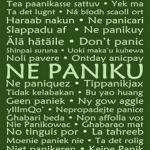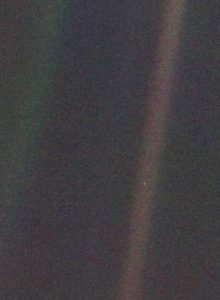by Jonathan Kujawa
What is a number? Everyone who takes high school math learns about the real numbers. These are our old friends on the number line. You can hardly do classical algebra or geometry without them. We use the real numbers so often we find them comfortable and familiar. After all, they are just numbers you write as a (possibly infinite) decimal. They may be long to write, but numbers like
1.41421356237309504880168872420969807856967187537694807317667973799…
don’t worry us.

Let’s back up a step or two. The integers (that is, the counting numbers and their negatives: 0,1,-1,2,-2,3,-3,,…) aren’t very controversial [1]. We can all agree what it means to have 7 goats, no goats, or that I have -3 goats when I owe my neighbor 3 goats. The rational numbers aren’t too bad, either. After all, to have 7/5 of a hamburger is to slice two burgers into 5 equal pieces each and to take seven of the pieces. And, again, to have -8/3 of a burger is to owe someone two burgers plus 2/3 of a third [2].
The integers and rationals are down to earth, as numbers go. However, it doesn’t take very long before you realize you need more numbers. One day in geometry class you draw a one-by-one square, notice you can draw a straight line which connects the opposite corners, and that line self-evidently has a length. Whatever that length is, it is an honest-to-goodness number (call it D) which exists in nature. At some point, you notice two one-by-one squares can be cut along the diagonal and reassembled into a single, larger square with side length D. On the one hand, the area of this new square is D². On the other hand, it is the area of the two smaller squares taken together. That is, D²=2. The Pythagoreans already knew 2600 years ago there is no rational number whose square equals two. The apocryphal story is the existence of non-rational numbers was a closely held secret for the Pythagoreans, worthy of murder. Nowadays we tell it to school children. So much for the innocence of youth.

Not very convincingly, we are told we now have all the numbers we need. But, you say, √2 snuck up on us unexpectedly, what if that should happen again? What about the solutions to x²+1=0? Everything is fine! No questions!
Like Martin Luther, you can’t help but ask uncomfortable questions. If real numbers are those you can write as a decimal, then you can write easily write down a real number such as
a=.999999999999999…
If it is a number, and if the usual rules of algebra apply to real numbers, then you might notice 10a = 9.999999999999999… and so 10a-9 = .999999999999999… That is, 10a-9 = a. Doing a little algebra shows a=1. That is,
1=.999999999999999…
This is alarming. The average person on the street will swear .999999999999999… is a wee bit smaller than 1. Can they really be equal? While it is true that an infinite sequence of 9’s equals 1, the above calculation isn’t on solid ground. In one of my first essays for 3QD I criticized a similar shady sleight-of-hand argument which supposedly shows
-1/12 = 1+2+3+4+5+6+7+8+9+10+…
In both cases, the truth is much more interesting. And in both cases, the real question is what do we mean when we write the right-hand side of the equation? In that essay I discussed how we have come to agree on a common understanding of how to interpret infinite sums [4]. This is the beautiful but much-maligned theory of infinite series usually taught in third term Calculus classes.
How about an infinite decimal? How do we interpret such a thing as a number?
My teacher may have explained it, but it was certainly lost on me that writing a number as a decimal is a short-hand for a sum. When we write 2.35817 what we really mean is 2 + 3/10 + 5/100 + 8/1000 + 1/10000 + 7/100000 [5]. If the decimal is infinite, then so is the sum.
Disturbingly, we’ve just discovered a decimal isn’t a number. Rather, it’s a shorthand which points to a number. To correctly decode to which number a decimal represents involves computing a potentially infinite sum. We were doing Calculus in fourth grade! It is by doing this infinite sum that we see 0.9999999… and 1.00000… both point to the same number. It seems the real numbers are more subtle than we were led to believe.
There is one bit of good news which comes out of writing real numbers as decimals: we see we can approximate a real number as closely as we like using a rational number. Even better, I can tell you exactly how to find the nearby rational number. All you need to do is take enough digits to be within the allowed error and toss the rest. For example, one of my favorite non-rational numbers is pi:
π=3.14159265358979323846264338327950288419716939937510…
Since π is irrational, its decimal expression goes on forever without repeating itself. Using fast algorithms and fast computers, we have computed more digits then any reasonable person could possibly want. The current record is Peter Trueb’s 2016 calculation of 22+ trillion digits of π. But if you are okay with using a decent approximation, then the rational number
3.1415926535897932384626433832795028841971
should suffice. This is already enough to calculate the circumference of the observable universe with an error smaller than an atom!
Since the rational numbers are arbitrarily close to any number on the real number line, it is reasonable to think they pretty much fill the number line. It is awfully tempting to say nearly all real numbers are rational. Actually, quite the opposite is true! 130 years ago Cantor gave a clever argument which showed there are more real numbers between 0 and 1 on the real line then there are rational numbers.
But maybe things aren’t so bad. I don’t mind non-rational numbers if they come up in a reasonable way. For example, √2 appears as the solution to the equation x²=2. What if we include all real numbers which appear as the solution of a polynomial equation which can be written using rational numbers? This includes all rational numbers, all roots of rational numbers, all numbers which can be constructed using a straightedge and compass (we discussed these numbers here), and much more besides. It doesn’t include π or Euler’s constant, e, but surely this must be most of the real numbers? Not even close! Once again, the tiniest segment of the real line contains more numbers.
Since this is the computer age, maybe we can expand our mind to include every real number which is “computable”. That is, we can write a finite computer program which, in a finite amount of time, can compute as many digits of the number as you like. These are called the computable numbers. Given Mr. Trueb’s calculations, it is probably no surprise π is a computable number. These also include all the algebraic numbers of the previous paragraph along with many, many others. In short, the computable numbers include all the real numbers which might show up in nature and definitely include all those we have any hope of computing or understanding. The others are no more knowable than an infinite sequence of coin tosses.
Surely, then, the computable numbers must be nearly all the real numbers? Not by a long shot. The computable numbers are countable — meaning they are closer to being the rational numbers than the real numbers. Even taking all the computable numbers, a sliver of the real line contains unimaginably more!

Rather like the humbling “Pale Blue Dot” photo of the Earth from space, we find the real numbers we can know and imagine are but dust sprinkled among the vastness of the number line.
[1] Although the philosophical, careful, and pedantic will argue this point. After all, it takes Bertrand Russell the better part of 100 pages in the Principles of Mathematics to define the integers.
[2] “I’ll gladly pay you Tuesday for a hamburger today.” — J. Wellington Wimpy.
[3] Image from here.
[4] Briefly, since we don’t know how to do an infinite sum, we instead make use of the fact we know how to compute a sum of finitely many numbers. We can calculate what we get if we add the first two numbers, or add the first three numbers, or the first four numbers, etc. Under favorable circumstances, the list of numbers we generate will get ever closer to a unique real number. We expand our notion of adding numbers by declaring the infinite sum is that number. For example, if we do this for 1/2 + 1/4 + 1/8 + 1/16 + …. we get 1/2, 3/4, 7/8, 15/16, … for our finite sums. This list of numbers can be shown to be getting arbitrarily close to 1. So we declare 1/2 + 1/4 + 1/8 + 1/16 + …. = 1.
[5] Also, we’ve all agreed to use base 10. That’s why there are 10, 100, 1000, etc. in the bottom of the fractions, and why only the digits 0, …., 9 are used in the decimal. Three-toed sloth mathematicians would probably use base six. Their fractions would have 6, 36, 96, in the bottom, their decimals would have 0, …, 5 as their digits, and they would fret over the fact that 1 = .5555555555… Changing the base is akin to changing fonts when you write. Its only effect is aesthetic.
